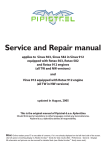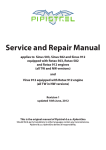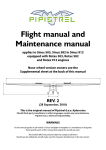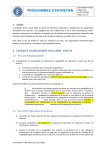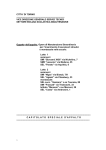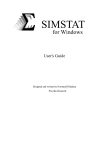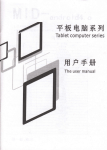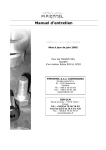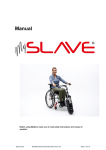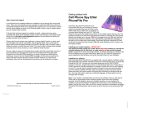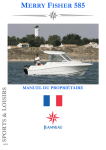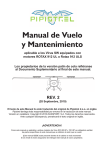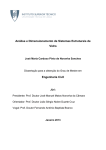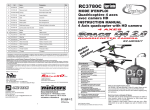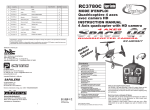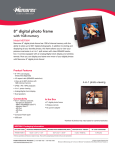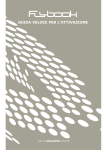Download Maintenence Manual
Transcript
Maintenence Manual applies to Sinus 912 LSA (glider), Virus 912 LSA (glider and aeroplane), Virus SW 80/100 LSA (aeroplane), equipped with Rotax 912 (80 HP) and 912S (100 HP) engines. Valid for tail-wheel and nose-wheel versions. ORIGINAL ISSUE (25 October, 2010) This publication includes the material required to be furnished to the pilot by ASTM F2245. WARNING! As this manual applies to several models of Pipistrel LSA aircraft, it is mandatory to designate those specific parts of this manual that regard the aircraft you operate. Copyright 2010, Pipistrel LSA s.r.l., Via Aquileia 75, 34170 Gorizia, Italy, EU 2 Service manual pipistrel.si Coverage The Maintenence manual (MM) is in the airplane at the time of delivery from Pipistrel LSA s.r.l. contains information applicable to the range of Pipistrel LSA aircraft mentioned on the cover. All information is based on data available at the time of publication. Supplements that cover non-standard are individual documents and may be issued or revised without regard to revision dates which apply to the MM itself. The Log of Effective Pages should be used to determine the status of each supplement. Revision tracking, filing and identifying Pages to be removed or replaced in the MM are determined by the Log of Effective pages located in this section. This log contains the page number and revision level for each page within the MM. As revisions to the MM occur, the revision level on the effected pages is updated. When two pages display the same page number, the page with the latest revision shall be used in the MM. The revision level on the Log Of Effective Pages shall also agree with the revision level of the page in question. Alternative to removing and/or replacing individual pages, the owner can also print out a whole new manual in its current form, which is always available from www.pipistrel.eu. Revised material is marked with a vertical double-bar that will extend the full length of deleted, new, or revised text added to new or previously existing pages. This marker will be located adjecent to the applicable text in the marking on the outer side of the page. The same system is in place when the header, figure, or any other element inside this MM was revised. Next to the double-bar, there is also a number indicative to which revision the change occured in. A list of revisions is located at the beginning of the Log Of Effective Pages Warnings, Cautions and Notes Safety definitions used in the manual: WARNING! Disregarding the following instructions leads to severe deterioration of flight safety and hazardous situations, including such resulting in injury and loss of life. CAUTION! Disregarding the following instructions leads to serious deterioration of flight safety. NOTE An operating procedure, technique, etc., which is considered essential to emphasize. Online updates, service notice tracking To log into the Owner’s section, receive relevant updates and information relevant to Service/ Airworthyness, go to: www.pipistrel.eu and log in the top right corner of the page with: Username: owner1 Password: ab2008 Service manual 3 pipistrel.si Index of revisions The table below indicated the Revisions, which were made from the original release to this date. Always check with your registration authority, Pipistrel USA (www.pipistrel-usa.com) or Pipistrel LSA s.r.l (www.pipistrel.eu) that you are fammiliar with the current release of the operation-relevant documentation, which includes this MM. Designation Original Reason for Revision / Release date 25 October, 2010 Affected pages / Issuer Tomazic, Pipistrel LSA s.r.l. 4 Service manual pipistrel.si Log of Effective Pages Use to determine the currency and applicability of your POH. Pages are affected by the current revision are marked in bold text in the Page Number column. Page number Cover i-1 i-2 i-3 i-4 i-6 i-7 0-1 0-2 1-1 1-2 1-3 1-4 1-5 1-6 2-1 2-2 2-3 2-4 2-5 2-6 2-7 2-8 2-9 2-10 2-11 2-12 2-13 2-14 3-1 3-2 3-3 3-4 3-5 3-6 3-7 3-8 4-1 4-2 Page Status Original Original Original Original Original Original Original Original Original Original Original Original Original Original Original Original Original Original Original Original Original Original Original Original Original Original Original Original Original Original Original Original Original Original Original Original Original Original Original Rev. number 0 0 0 0 0 0 0 0 0 0 0 0 0 0 0 0 0 0 0 0 0 0 0 0 0 0 0 0 0 0 0 0 0 0 0 0 0 0 0 Page number 4-3 4-4 4-5 4-6 5-1 5-2 5-3 5-4 5-5 5-6 6-1 6-2 6-3 6-4 6-5 6-6 7-1 7-2 7-3 7-4 7-5 7-6 7-7 7-8 7-9 7-10 8-1 8-2 8-3 8-4 8-5 8-6 9-1 9-2 9-3 9-4 9-5 9-6 9-7 Page Status Original Original Original Original Original Original Original Original Original Original Original Original Original Original Original Original Original Original Original Original Original Original Original Original Original Original Original Original Original Original Original Original Original Original Original Original Original Original Original Rev. number 0 0 0 0 0 0 0 0 0 0 0 0 0 0 0 0 0 0 0 0 0 0 0 0 0 0 0 0 0 0 0 0 0 0 0 0 0 0 0 Service manual 5 pipistrel.si Log of Effective Pages (continued) Page number 9-8 9-9 9-10 9-11 9-12 9-13 9-14 9-15 9-16 9-17 9-18 9-19 9-20 10-1 10-2 10-3 10-4 10-5 10-6 Checklist Page Status Original Original Original Original Original Original Original Original Original Original Original Original Original Original Original Original Original Original Original Original Rev. number 0 0 0 0 0 0 0 0 0 0 0 0 0 0 0 0 0 0 0 0 Page number Page Status Rev. number 6 Service manual pipistrel.si This page is intentionally left blank. Service manual 7 pipistrel.si Table of contents General Servicing the aircraft Schematics 8 Service manual pipistrel.si This page is intentionally left blank. Service manual 9 General pipistrel.si General Introduction Notes and remarks Materials used in manufacturing process Assembling and disassembling the aircraft Keeping your aircraft in perfect shape 10 Service manual pipistrel.si General Introduction This manual contains all information needed for appropriate and safe servicing of Sinus 912 LSA, Virus 912 LSA, Virus SW 80/100 LSA In case of aircraft damage or people injury resulting form disobeying instructions in the manual PIPISTREL LSA s.r.l. denies any responsibility. All text, design, layout and graphics are owned by PIPISTREL LSA s.r.l. Therefore this manual and any of its contents may not be copied or distributed in any manner (electronic, web or printed) without the prior consent of PIPISTREL LSA s.r.l. IT IS MANDATORY TO CAREFULLY STUDY THIS MANUAL PRIOR TO USING/SERVICING OF THE AIRCRAFT Notes and remarks Safety definitions used in the manual: WARNING! Disregarding the following instructions leads to severe deterioration of flight safety and hazardous situations, including such resulting in injury and loss of life. CAUTION! Disregarding the following instructions leads to serious deterioration of flight safety. NOTE An operating procedure, technique, etc., which is considered essential to emphasize. Service manual 11 General pipistrel.si Materials used in manufacturing process Composite parts are made of: fabric: GG160, GG200, 90070, 92110, 92120, 91125, 92140, 92145, KHW200 roving: NF24 foam: 75 kg/m3 PVC 3mm, PVC 5 mm, PVC 8mm GFK: 3 mm, 5 mm, 7 mm of thickness paint: acrylic paint firewall glass-aluminium sandwich Medal parts used are: tubes: materials: Fe0146, Fe 0147, Fe0545, Fe1430, AC 100, CR41 in LN9369 sheet metal: rods: materials: Fe0147 in Al 3571 materials: Fe 1221, Fe 4732, Č4130, Al 6082, CR41 in Al 6362 cable: AISI 316 bolts and nuts: 8/8 steel All composite parts are made of glass, carbon and kevlar fiber manufactured by Interglas GmbH. All parts have been tested at safety factor of a minimum 1.875. All parts and materials used in Pipistrel LSA aircraft are also being used in the glider and general aviation industry and all comply with aviation standards. All parts are made in moulds, therefore no shape or structural differences can occur. All desinging, manufacturing and testing complies with following regulations: • Bauvorschriften für Ultraleichtflugzeuge des Deutschen Aero Club e.V. Beauftragter des Bundes-ministeriums für Verkehr • JAR-1 microlight definition • EASA CS-22 - certain sections • EASA CS-VLA -certain sections for Slovenian market also: Pravilnik o ultralahkih napravah Republike Slovenije. WARNING! WHEN SERVICING OR REPLACING PARTS ALWAYS USE THE SAME MATERIAL AS USED ORIGINALLY SEE ABOVE. 12 Service manual pipistrel.si General Assembling and disassembling the aircraft CAUTION! Prior to each assembling or disassembling action Virus SW must be placed inside a closed space. Under no circumstances attempt to assemble or disassemble any parts of the aircraft in the sun or at temperatures higher or as high as 20°C for you will not be able to assemble certain parts. Assembling the wings Three people are needed to assemble the wings to the fuselage. First block all three wheels for the fuselage to stay in position. Clean and grease the main wing pins and insertion openings. Inside the cockpit set the flap handle to neutral position and leave the spoilers’ handle hanging down freely. Make sure you have all bolts, nuts, washers and spanners needed at a reach of a hand. Lift one wing-half (one person at each end) and bring it closer to the fuselage. While the two are holding the wing-half high up, the third person directs their movement to put the wing’s main spar into the opening on the adjacent side of the fuselage. As the wing is about 10 cm away from its final position, fit the electrical cables, fuel hose and pitostatic lines through the opening. Now push the wing-half into its final position slowly. The person closest to the fuselage must make sure the spoiler and flap connectors have fitted into adequate fuselage fittings properly. At the same time, the person holding the wingtip must start with slight circular movements (1cm each direction) in order to assure a tight fit of the wing and its adequate bushings. As this is done the person at the wingtip must remain in positon holding the wing, whereas the other two move over to the other winghalf, lift it and bring it closer to the fuselage. Again, all cables, hoses and lines must be fitted through the openings prior the wing-half being pushed into its final position. Do not forget to make sure the spoiler and flap connectors have fitted into adequate fittings properly on this wing-half as well. Both wing-halfs should now be in their final position but still being held at wingtips. The person not holding the wings must now open the cabin door and insert both pre-greased spar pins. First insert the pin on the right-hand side of the cockpit because of easier insersion (thinner spar infront), then the pin on the lefehand side of the cockpit. If necessary, the two at the wingtips can assist by rocking the wings a couple of millimeters up and down. Only when both spar pins have been inserted and secured, wingtips may be released and door fully opened and fastened to the wing. Now check all control deflections as well as flap and spoilers’ extensions for smooth, unobstructed movement. Insert all bolts and pins and secure them with self-locking nuts. Do not forget to put aluminium washers underneath the nuts! Connect all electical clables, fuel hoses (fixed or click-on connectors!) and pitostatic lines to their adequate fittings. Check for adequate fuel flow through the fuel connectors before attempting the first flight (1 liter / 1 quart per minute). For fixed fuel connectors make sure you have tightened the metal clamp around the tube securely! Screw on the pitot tube on bottom side of the right wing at aproximately 2/3 of the wingspan. Be extra careful not to switch the two tubes as this causes misinterpretation of indicated airspeed! Finally tape the gap between the fuselage and the wing using self-adhesive tape. pipistrel.si Service manual 13 General Disassembling the wings Three people again are needed to disassemble the wings. First block all three wheels for the fuselage to stay in position. Empty both fuel tanks by opening both fuel valves inside the cockpit and the drain valve beneath the bottom engine cover. Place a canister under the drain valve to intercept fuel. While you wait for the tanks to empty, disassemble the horizontal tail surfaces, disconnect all electrical cables and pitot-static lines. Do not forget to unscrew the pitot tube on the bottom side of the right wing. Then, inside the cockpit, unscrew the middle main spar screw first, then unscrew and remove both pin bolts. WARNING! Do not remove spar pins yet! Once the fuel tanks are empty, disconnect the fuel hoses inside the cockpit as well. Schematic of wing (dis)assembly Make sure you tape the end attached to the wing not to spill any eventual leftover fuel over the fuselage or glass surfaces as substantial damage may occur. Two people must now lift the wingtips (one wingtip each) and the person in the cockpit remove the main spar pins, one by one, smoothly. Forcing pins out of their position may result in structural damage, therefore the wingtip holders must hold the wing-halfs precisely at certain height! Using slight circular movement at the wingtip, the wing-halfs must now be pulled out of the fuselage slowly. On pulling, each wing-half must be held by two, one at the wingtip and one near the spar. As the wing-halfs have been pulled out, place them onto a soft surface to prevent their damage. 14 Service manual pipistrel.si General Fitting the horizontal tail surfaces Horizontal stabilizer and elevator MUST be united during the following procedure. To fit the horizontal tail surfaces first set the trim handle inside the cockpit to full forward position. Make sure the pins, their holes and bushings have been cleaned and greased! Lift the joint stabilizer and elevator and slide them into position by pushing them backwards while the elevator is deflected DOWN fully. Now use the enclosed “T” key to push the security screw down while spinning it clockwise until the screw is completely tightened. Pull the “T” key out and make sure the safety pin holds the head of the screw, so that eventual unscrewing will not occur. At the end tape the gap between horizontal and vertical tail surfaces and cover the hole on top of the vertical stabilizer with a sticker. Check control deflections for smooth, unobstructed movement. Detaching the horizontal tail surfaces Set the trim handle to full forward position and remove the safety sticker covering the hole on top of the horizontal stabilizer and the tape covering the gab between horizontal and vertical tail surfaces. Now use the enclosed “T” key to push the safety pin screw down while spinning it counter-clockwise until it is completely loose. To detach the horizontal tail unit push it forward using firm palm strokes until the unit pops out. When detached, always place the horizontal tail unit onto a soft surface to prevent damage. Schematic of horizontal tail surfaces (dis)assembly pipistrel.si Service manual 15 General Attaching the rudder Bring the rudder close to fuselage and fit it first onto the top and then to the bottom hinge. The rudder must then be fully deflected to one side to provide access to the rudder bolts. Use a selfsecuring, pre-glued M10 nut together with an aluminium washer and gently screw them onto the bolt using size 10 spanner. To reach the other rudder bolt deflect the rudder to the opposite direction and repeat the up-stated procedure. With both nuts tightened check full rudder deflections for smooth, unobstructed movement. Detaching the rudder Deflect the rudder to one side fully and unscrew the nut of the bolt with which the rudder is attached to the bottom hinge. This is the bolt located in-between the central bolt (axis of rotation) and the bolt holding the metal ropes. DO NOT touch these two bolts - unscrew the nut of the middle bolt ONLY. Now deflect the rudder to the opposite direction and repeat the up-stated procedure. After both bolts have been unscrewed, lift the rudder and detach it first from the bottom, then from the top hinge. Schematic of rudder (dis)assembly 16 Service manual pipistrel.si General Keeping your aircraft in perfect shape Precautions 1) Eliminate the use of ALL aggressive cleaning solutions and organic solvents, also the window cleaning spray, benzene, acetone, aggressive shampoos etc. 2) If you must use an organic solvent (acetone) on small areas remove certain glue leftovers or similar, the surface in question MUST be polished thereafter. The only section where polishing should be avoided is the edge on the wing where the sealing gasket is applied. 3) When flying in regions with a lot of bugs in the air, you should protect the leading edges of the airframe before flight (propeller, wings, tail) with Antistatic furniture spray cleaner: “Pronto (transparent), manufacturer: Johnson Wax (or anything equivalent) – Worldwide”, approximate price is only $3 USD / €3 EUR for a 300 ml spray bottle. Using such spray, do not apply it directly onto the wing but into a soft cloth instead (old T-shirts are best). 4) After having finished with flight activity for the day, clean the leading edges of the airframe as soon as possible with a lot of water and a drying towel (chamois, artificial leather skin). This will be very easy to do if you applied a coat of Pronto before flight. Detailed handling (Airframe cleaning instructions) Every-day care after flight Bugs, which represent the most of the dirt to be found on the airframe, are to be removed with clean water and a soft cloth (can be also drying towel, chamois, artificial leather skin). To save time, soak all the leading edges of the aircrame fist. Make sure to wipe ALL of the aircraft’s surface until it is completely dry at the end. Clean the propeller and the areas with eventual greasy spots separately using a mild car shampoo with a wax. CATUION! Do not, under any circumstances attempt to use aggressive cleaning solutions, as you will severely damage the lacquer, which is the only protective layer before the structural laminate. When using the aircraft in difficult atmospheric conditions (intense sunshine, dusty winds, coastline, acid rains etc.) make sure to clean the outer surface more thoroughly. If you notice you cannot remove the bug-spots from the leading edges of the aircraft, this means the lacquer is not protected any more, therefore it is necessary to polish these surfaces. CAUTION! Do not, under any circumstances attempt to remove such bug-spots with abrasive sponges and/or rough polishing pastes. Periodical cleaning of all outer surfaces with car shampoo Clean as you would clean your car starting at the top and working your way downwards using a soft sponge. Be careful not to use a sponge that was contaminated with particles e.g. mud, fine sand) not to grind the surface. While cleaning, soak the surface and the sponge many, many times. Use a separate sponge to clean the bottom fuselage, as is it usually more greasy than the rest of the airframe. When pouring water over the airframe, be careful not to direct it over the fuel reservoir caps, wingfuselage joining section, parachute rescue system straps and cover, pitot tube, tail static probe and engine covers. pipistrel.si Service manual 17 General Always rinse the shampooed surfaces again before they become dry! Thereafter, wipe the whole of the aircraft dry using a drying towel, chamois or artificial leather skin. Also, clean the Mylar seals on the wing and tail control surfaces. Lift the seals gently and insert ONE layer of cloth underneath, then move along the whole span of the seal. Ultimately, you may wish to apply Teflon grease (in spray) over the area where the seal touch the control surfaces. Polishing by hand Use only the highest quality polishing compounds WITHOUT abrasive grain, such as Sonax Extreme or similar. Start polishing on a clean, dry and cool surface, never in the sunshine! Machine polishing requires more skills and has its own particularities, therefore it is recommended to leave it to a professional. Cleaning the Lexan transparent surfaces It is most important to use really clean water (no cleaning solutions are necessary) and a really clean drying towel (always use a separate towel ONLY for the glass surfaces). Should the glass surfaces be dusty, remove the dust first by pouring water (not spraying!) and gliding your hand over the surface. Using the drying towel, simply glide it over the surface, then squeeze it and soak it before touching the glass again. If there are bugs on the windshield, soak them with plenty of water first, so less wiping is necessary. Ultimately, dry the whole surface and apply JT Plexus Spray ($10 USD / €10 EUR per spray) or at least Pronto antistatic (transparent) spray and wipe clean with a separate soft cotton cloth.” 18 Service manual pipistrel.si General This page is intentionally left blank. Service manual 19 Servicing the aircraft pipistrel.si Servicing the aircraft Introduction Priviliges Line maintenence / Inspection periods Special check-ups Fibre reinforced plastic repairs Example of flapperon FRP repair Example of wing FRP repair Weight and Balance 20 Service manual pipistrel.si Servicing the aircraft Introduction This chapter determines periodic (line) maintenence and handling of various items. Templates for Letters of Authorisation are provided at the back of this MM. Priviliges There are four levels of proficiencies, indicating which jobs can be carried out with which priviliges. They are marked as prefixes in the table of Line maintenence: Level “a”: Owner (do it yourself, automatic authorisation with this MM). Level “b”: LSA repairman or A&P mechanic, also owners themselves in presence of an A&P mechanic. Level “c”: Licenced A&P mechanic, any level. Level “d”: Pipistrel LSA/Pipistrel USA Factory Service Center . Owners are encouraged to take care of preventative maintenance yourself. This includes: tire and wheel bearings replacements, safety wire replacements, door and safety harness replacement, light bulb replacements, fuel hose replacements, battery servicing and replacement, sparks and spark plugs replacements and air filter replacements. Rotax training requirements for working on LSAs still apply. With level “b” and “c”, at least one of the persons carrying out the tasks must have received Pipistrel LSA/Pipistrel USA Factory training. Line maintenence / Inspection periods The table below indicates recommended maintenance periods (see Service manual for detailed information). Table legend: C Check-up - visual only, check for free play and whether everything is in position CL LO R SC O Cleaning Lubricating, oiling - lubricate all designated parts and spots using proper lubricant Replacement - replace designated parts regardless of state and condition. Special check-up - measuring, verifying tolerances and functionality Overhaul daily WING AND TAIL SURFAaCES surface and structure condition deflections without free play bearings - moving parts’ bushings lights self-adhesive sealing tape horizontal tail mount drain holes first 5 50 100 200 500 1.000 10.000 hours hours hours hours hours hours hours bSC aC aC aC aC aC aC aCL bSC bSC bSC aC aC bSC bSC dO Service manual 21 Servicing the aircraft pipistrel.si daily FUSELAGE surface and structure condition elevator control tube bearing undercarriage struts attaching points doors, hinges rudder control wires and hinges CABIN control levers, instr. panel, seats control levers’ free play intstruments and pitot-static glass surfaces: clean, attached rivet condition safety harnesses and attach. points parachute rescue sys. activation handle wing connectors: fuel, electrical bolts and spar pins wing main bushings, control connectors UNDERCARRIAGE tires main strut, tail /nose wh. strut condition wheel axis and wheels hyd. brake lines brake fluid brake discs wheel bearings wheel fairings tail wheel attachment bolt fist 5 50 100 200 500 1.000 10.000 hours hours hours hours hours hours hours aC aC aC aC aC aC aC aC aC aC aC aC aC aC aC aC aC aC aC aC aC bSC bSC aC bSC bSC dO bSC dO bSC aLO bSC bSC bSC c check yearly bSC bSC bSC bSC bSC bSC bSC aC aC aC aC dO level “a” replace on condition or every 5 years aC bSC aC bSC cR bSC bR (500 hrs or 5 years) bSC (bR on condition) aC bSC bR aC aC leveel “a” fasten every 50 landings dR CONTROLS (aLO every 200 hrs or yearly) aC aC general free play aC control stick aC rudder pedals (damage, centered, paral.) aC aC rudder wire rope bolts, visible bearings (tail, fuselage) difficult-to-reach bearings (wings, under cabin floor) aileron, elevator and rudder hinges aC equal spoiler extension, undisrupted m. aC spoiler plate springs stiffness aC flap handle bSC aLO aC bSC bSC bSC bSC bSC bSC bSC aLO bSC aC elevator trim springs: flaps, rudder, el. trim, stablizer main fastening bolt spoilers’ (airbrakes’) drive fine adjustment (level b) cR cable every 500 hrs aLO aC bR see page 23 for detailed description 22 Service manual pipistrel.si Servicing the aircraft daily ENGINE first 5 50 100 200 500 1.000 10.000 hours hours hours hours hours hours hours see enclosed Rotax engine manual for detailed engine maintenance information. In addition to Rotax manual: two-stroke engines (overhaul every 300 hours) four-stroke engines (overhaul every 1,500 hours) engine cover screws aC aC engine mount aC aC engine mount dumpers and other aC rubber parts air filters aC aC elect. terminals, joints and aC aC connectors, hoses, radiator mount exhaust muffler aC aC exhaust pipe springs and fire protect. aC aC throttle, choke, propeller wire drive ENGINE CONTROL choke and throttle lever wire ropes levers PROPELLER AND SPINNER surface condition fastening bolts propeller bushings propeller pitch propeller balance FUEL SYSTEM general leakage water inside gascolator dirt and gascolator filter wing fuel tank caps fuel tank caps o-ring fuel valves and leakage ELECTRICAL WIRING battery battery fluids instr.panel wires and connectors NAV, AC and LDG lights fuses aC from engine serial number 4404718 aC bSC level “c “R every 500 bSC hrs or every 5 years bCL bSC bSC bSC bSC bSC bSC cR cR dO aC aC aC bSC bSC cR bSC cO aC bR bR bSC bSC aC aC aC aC cO every 1000 hrs or 5 years bSC aC aCL aCL aCL bR aC level “a” R every 500 hrs or 5 years aC bSC aC aC aC aC aC aC aC aC bSC bSC aC aC cR Service manual 23 Servicing the aircraft pipistrel.si daily OIL AND WATER LINES oil and cooling fluids level oil and cooling fluids leakage four stroke engine oil (and engine filter) first 25 hours + cooling fluid (level) hoses radiators water radiator pressure cap aC aC first 5 50 100 200 500 1.000 10.000 hours hours hours hours hours hours hours cO every 500 hrs or 5 years aC aC refer to engine manual aC aC aC aC refer to engine manual R refer to engine manual bSC PITOT-STATIC LINING instrument to pitot tube lining instrument setting pitot tube condition (clean, firmly att.) whole pitot-static lining aC aC aC aC aC aC aC aC Spoilers’ (airbrakes’) drive fine adjustment CAUTION! Perform this operation only once after first 50 flight hours! Check spoilers thoroughly for unobstructed, smooth and even extention every 200 flight hours! Schematic of spoilers’ (airbrakes’) drive fine adjustment (see next page for detailed description) 2 1 5 3 4 4 cO 24 Service manual pipistrel.si Perform the adjustment as follows: 1 Unscrew and remove the inner horizontal bolt of the airbrake’s plate. Do not lose any parts! 2 Lift the airbrake in order to make room for further operation. 3 Unscrew and remove the bolt attaching the rod-end bearing to the airbrake’s plate lever. Do not lose any parts! 4 Rotate the rod-end bearing fine-setting nut 360° so that the rod end moves towards the other end of the airbrake’s box (length of rod increases). Make sure you secure this nut after turning it for 360°! 5 Grease the drive around the rubber sleave inside the airbrake’s box using rubber-nonagressive lubricant spray. Once you have accomplished this, repeat steps 1-3 in opposite order (3,2,1). Make sure you apply adhesive (e.g. Loctite) on all screws when reattaching! Perform the procedure at the other airbrake as well. In the end verify airbrakes for equal extension. WARNING! Should the airbrakes not retract evenly, apply step action 4 again for the airbrake, which remains higher when retracting. Vital stages of spoilers’ (airbrakes’) drive fine adjustment in pictures Spoiler’s (Airbrake’s) plate 1 Rod-end bearing 3 4 Horizontal bolt of the AB’s plate 1 pipistrel.si Service manual 25 Clicking noise overhead The wings are factory fitted to the fuselage to make a tight fit at approximately 20° Celsius. When exposed to low temperatures, materials shrink. Therefore, flying in the winter or in cold temperatures, you may encounter “click-clack” like noises above your head. The remedy for this unpleasant noises is to add washers, tipically of 0,5 mm thickness in-between wing and fuselage. Washers must be added both at rear and front bushings at one side of the fuselage only! WARNING! It is mandatory to consult the manufacturer or authorised service personnel before applying washers! Adjustment of tail wheel steering clutch stiffness To adjust the stiffness of tail wheel stearing clutch you need two allen keys (a.k.a. hex-wrench, inbuskey). On top of the wheel fork you will notice a ring with two tubes welded to each side with hexbolts inside. First disconnect the springs at the tubes, then stick an allen key into each of these tubes and tighten or loosen the screw inside. Make sure, thightening or loosing, you apply equal number of screw rotations at both sides. To check if the steering clutch is stiff enough, lift the tail and rotate the fork left and right. At the end, reattach both springs to the tubes again. (see Service manual for photos) Bleeding the hydraulic brakes In case you notice poor braking action even when hydraulic brake levers are depressed fully, it is most definitely necessary to vent the hydraulic lining. To do so, first unscrew the caps of small fluid reservoars (behind rudder pedals on one side of the cockpit) and remove the inner seal cap. At the side where there are no fluid reservoars grab the whole rudder pedal and deflect it back fully, so that it becomes level with the cockpit’s floor beneath. Now, at the side where there are flud reservoars, jerk brake levers back and forth a couple of times - this will push air bubbles towards the reservoar and out of the lining. When convinced air bubbles are no more, put seal caps back onto the reservoars and screw the caps on as well. Repeat the procedure for the other brake lever. WARNING! Should you encounter any difficulties during this procedure or the air bubbles would not vent, please consult the manufacturer or authorised service personnel for further instructions. 26 Service manual pipistrel.si Schematic of hydraulic brakes’ lining Poor braking action In case you notice poor braking action even when hydraulic brake levers are depressed fully, it is not necessary the air bubbles in the hydraulic lining, which is causing the problem. The main wheel’s main axis’ nut (especially after a wheel and/or axis replacementnut) may be tightened incorrectly so that the brake shims do not make contact with the brake plate. Please consult the manufacturer or authorised service personnel for further information. Schematic of wheel and wheel brakes Service manual 27 pipistrel.si Connecting Auxilliary power supplies Should you be unable to start the engine due to a weak battery, auxilliary power supplies can be connected to help starting the engine. Battery’s & Relay’s location Battery (black) & Relay (top-right) Top-left nipple (c. positive (+) wire here) Exhaust (connect negative (-) wire here) To connect an auxilliary power supply use battery connector cables with clamps at either ends. Connect the negative (-) wire to aircraft’s exhaust (sticking out below the engine cowlings). The positive (+) wire leads inside the cockpit to the relay mounted top-right of the aircraft’s battery on the firewall. This relay has 3 nipples; the positive (+) wire must be connected to the upper-left nipple, the only one to which 2 cables are connected to. After you have connected the wires correctly, start the engine normally by pressing the starter button in the cockpit. WARNING! The pilot must be in cockpit when starting the engine. The person who will disconnect the cables after the engine has started must be aware of the danger of spinning propeller nearby. 28 Service manual pipistrel.si Servicing the aircraft Fibre reinforced plastic repairs WARNING! Do not, under any circumstances attempt to repair damages greater than 50 mm in size (on wing) and/or 20 mm in size on any control circumstances. These require a treatment by a FRP professional! Definition of minor damage Only the damage listed below can be considered as minor damage repairable by oneself. Any damage limited to gelcoat or filler. Holes in the fuselage underside where the average diameter does not exceed: Forward fuselage: 50 mm Rear fuselage: 50 mm Cracks in fuselage underside max. Forward fuselage: 50 mm Rear fuselage: 50 mm The fuselage glued joint (rear fuselage) should not be damaged. Holes, cracks and tears, bubbles etc. in the wings, horizontal stabilizer and control surfaces skins where the damage does not exceed (average diameter crack length): Wings: 50 mm (50 mm) Horiz.ontal stablizer: 20 mm (20 mm) Rudder: 20 mm (20 mm) Flaperon, Elevator: 20 mm (20 mm) The above parts should not be damaged in the spar area. Damaged fittings should not be repaired but replaced. Facilities To insure proper curing, the room temperature during repair work and at least 12 hours afterwards should be maintained at 21°C (70° F). After that the repaired parts are to be tempered. Therefore you may construct a tempering tent, using plastic film or Styrofoam plates. Filler For gluing, the resin-hardener mix should be thickened with chopped cotton fibres FL l f. (add enough so that the resin no longer flows). The surfaces to be glued should be wetted with non-thickened resin & hardener before. To glue foam pieces into place when repairing sandwich sections and to fill in irregularities and gaps etc. around the repair, Microballoons BJO - 0930 can be used mixed with the resin-hardener. Application and mixing is the same as for the cotton flocks. WARNING! Only materials listed on page 9 should be used. Only damage defined above should be repaired. pipistrel.si Service manual 29 Repair method for FRP Cut out damaged area, roughen the surrounding area for the overlap required. Repairs should be made such that bonding is wet over dry. Specific details concerning handling and using fibre reinforced plastics can be obtained from various publications ie. “Petite Plane Patch Primer.” The use of Carbonfibre is the same as for glasfibre, except that the carbonfibres should not be kinked and only the specified resins are used. WARNING! All repairs should be tempered for 20 hours at 54°C before the next take off. Repairs of the FRP shell Prepare the repair area as specified above. Scarf the shell so that the individual layers of fabric can be seen like plywood layers. Remove the gelcoat for at least 20 mm around the damaged area. Repairing the outer skin of a sandwich panel Cut out the damaged area, remove the gelcoat over the overlap area and 10 mm around the damaged area. Fill the damaged foam area with resin thickened with microballoons (microballoons-resin), let harden. Sand down. With a round headed hammer tap the outer skin around the hole so that the foam is somewhat compressed, therefore heat this area to ca. 60°C (140°F). Apply the new cloth. Repair of outer and inner skin of a sandwich panel Additionally remove as much foam as is needed so that the entire damage to the inner skin can be seen plus enough undamaged inner skin as is required for overlapping. If the inner skin still holds together, sand properly and lay up the new cloth over it. Insert a suitable cut piece of foam, 1-2 mm thinner than the original, glued in with microballoons-resin. Should the inner skin be so damaged that the above process cannot be use the inner skin fabric should be applied to the foam first and left to harden before inserting into the repair area. Microballoons-resin should once again be used. For lay up of the fabric to the foam, a layer of microballoons-resin should be applied first to eliminate the formation of airbubbles. Apply outer layers Special hints for processing aramidfibres The difficulties processing aramidfibre starts already when cutting the fabric. Only with very sharp tools (toothed scissors) cutting the material is possible. Sanding the fibres is not possible without formation of fluff or fuzz. Only wet sanding is feasible. After sanding, the area must be dried with a fan heater. Aramidfibre has the tendency to take up humidity. Therefore dry storage and drying the fibres prior to processing is necessary. Aramid must be protected against UV-rays before and after processing. An aramid repaired area must be protected by a paint with UV-protection. Thin aramidlayers can’t be scarfed. Only overlapping is possible. Repair of the carbonfibre - aramidfibre – hybrid fuselage shell With this construction the repair method see mentioned above is not applicable. Contact the manufacturer. 30 Service manual pipistrel.si Repairing small dents in a sandwich panel skin (no cracks in the gelcoat) Small dents can usually be removed by heating up to 60° to 70° C (140° -158°F). Use a hot air blower to heat the area of the dent. The crushed foam will then spring back to its original form, so that the dent will hardly be seen. Final sanding with wet sandpaper grade 600 should finish the job. In more severe cases, one coat of gelcoat will remove all trace of the dent. Outer skin finish Repairs should be such that the area is exactly level or only slightly higher than the surrounding skin surfaces. Sand the hardened repair surface with dry grade 80 sandpaper. Fill with Polyesterfiller, let dry and sand with dry sandpaper. When the surface is smooth, sand the repair area and at least 5 cm (2 in.) of the surrounding gelcoat with wet sandpaper grade 400. Spray the repair area with 5 coats of gelcoat. After the gelcoat has hardened, sand with grade 400, 600 and 800 wet sandpaper until the surface is smooth. Polish with a power buffer (electric drill or similar with cloth polishing wheel). Apply a block of wax onto the rotating polishing wheel and then polish the repaired area. Do not polish in only one direction, and do not polish one spot for too long to prevent material overheating. WARNING! After repairing control surfaces, the mass balance weights MUST be checked again with the values given in the maintenance manual. Should the maximum values be exceeded, then the parts have to be replaced. pipistrel.si Service manual 31 Example of flapperon FRP repair WARNING! Do not, under any circumstances attempt to repair damages greater than 50 mm in size (on wing) and/or 20 mm in size on any control circumstances. These require a treatment by a FRP professional! Phase I Carefully cut and remove the damaged foam (Herex 3 mm) in width of at least 20 mm around the damaged area. Clean the area, paying special attention that the inner fabric is immaculate.This is of vital importance. After you have cleaned and rinsed everything, laminate the 20 mm area according to the laminate-plan shown on the drawing below. Laminate plan for flapperon WARNING! if the damage area is located on the flap hinge (the fabric used there is carbon fibre - black colour) you must laminate using one ply of GG160 fabric, oriented diagonally to the flight direction. Also, you must apply Peel Ply on top of GG160. 32 Service manual pipistrel.si Phase II Remove the Peel Ply and adapt a new piece of foam (Herex 3 mm) as accurately as you possibly can and glue it with microballoons. WARNING! Do not apply too much pressure anywhere! Phase III Grind the foam if its level is too high. Also grind the external laminate around the cut-out for about 25 mm in a conical-shape (see next drawing). When done, laminate as follows: - Place one (1) piece of GG160 diagonaly and - One (1) piece of 90070 perpendicular to the flight direction. Phase IV Grind only the outer edge of the new fabric. When done, the new surface is ready to be painted. pipistrel.si Drawing of skin final repair Service manual 33 34 Service manual pipistrel.si Example of wing FRP repair WARNING! Do not, under any circumstances attempt to repair damages greater than 50 mm in size (on wing) and/or 20 mm in size on any control circumstances. These require a treatment by a FRP professional! Phase I Preparing the surface. Carefully clean the damaged foam and check if there is also a damage on the inner fabric. If the inner fabric in not damaged fill the hole with microballoons as you can see on the drawing below. In case the hole is through the inner fabric as well, you have to repair the inner fabric, too. The new patch must be at least 20mm bigger than the damaged area. You also have to replace (glue) the missing foam with a new one. Gap filling drawing pipistrel.si Service manual 35 Phase II Laminating. Grind the outher fabric in a shape of a cone at least 25mm around the damaged area (see drawing below) and laminate only the grinded surface with fabrics as follows: - Two (2) pieces of 92110 and - One (1) piece of 90070 When laminating be careful about the orientation of the fibres. The fibres of 92110 must be put diagonally to the flight direction, the fibres of 90070 must be put perpendicular to this direction. The directions are also shown in the drawing below. Phase III Grinding. You can grind only the surface (ring) around the damaged area. This surface is shawn in previous drawing. When done the surface is ready for painting. 36 Service manual pipistrel.si Weight and balance Weight and Balance This chapter provides information on aircraft’s weight and balance, which is essential for safe flying activity. Weighing procedure Make sure all listed aircraft parts and appliances are installed and in position. Remove all other objects (e.g. tools, mops, tie downs and other items ...). Empty fuel tanks except for the unusable fuel, inflate tires to recommended operating pressures. Fill up engine oil to the top marking. Retract flaps and airbrakes (optional), leave control surfaces centred. Level the aircraft inside a closed space - use the provided airfoil template at lower side of the wing close to the wing root and make sure its straight edge is level (horizontal). Once leveled, read the scale readings and subtract eventual tare weight. Now record all readings and fill out the bottom table. CG lever arm formula for Tail-wheel aircraft (Sinus TW, Virus TW, any model): Lever arm of CG (X) = ((G2 / G) x b) + a CG lever arm formula for Nose-wheel aircraft (Sinus NW, Virus NW, any model): Lever arm of CG (X) = ((G1 / G) x c) - a Weighing form (TAILWHEEL) Weighing point and symbol right main wheel (GD) left main wheel (GL) tail wheel (G2) total (G = GD + GL +G2) Scale reading Tare Nett Service manual 37 Weight and balance pipistrel.si Weighing form (NOSEWHEEL) Weighing point and symbol right main wheel (GD) left main wheel (GL) nose wheel (G2) total (G = GD + GL +G2) Scale reading Tare Nett Determination of CG Weight (kg) Weight’s lever arm (cm) Torque (kgcm) Remarks Basic cfg. emtpy weight CAUTION! Each newly installed part or appliance must be registered in the upper table. Also, new total weight and lever arm of CG values must be entered and position of CG re-determined. Furthermore, the moment must be recalculated. This is rather easy to do. First multiply the new part’s weight by it’s lever arm measured from the reference point (wing’s leading edge). Then sum up all momentums and divide the sum by the new total weight. WARNING! Regard to the POH for the specific aeroplane for allowable C.G. limitations! 38 Service manual pipistrel.si Sample c.g. calculation Guidelines Gtotal is the total mass of empty aircraft. All calculations can be performed with aircraft empty weight and empty weight centre of gravity (c.g.), as the pilots sits directly below the centre of gravity and do not cause the c.g. to be shifted. The amount of fuel quantity also has no impact on the c.g.. WARNING! Both pilots’ weight and weight of fuel do not influence c.g. or their influence is insignificant. However, baggage can influence the c.g. severely and may cause the aircraft to become uncontrollable! Basic CG formulas and calculation The below instructions are valid for Virus Tail Wheel and Nose Wheel editions. Read thoroughly. Note also that the basic c.g. at 287 mm will be used purely as an example. First, weigh the aircraft according to the procedure described in this chapter and write down values of G1 (sum of scale readings at main wheels) and G2 (scale reading at tail/front wheel). Then calculate the position of c.g. in milimeters (mm) from the datum (wing’s leading edge at wing root). For Tail wheel edition of Virus use the following formula: CGmm = G 2tail · b G 2tail · 4300mm +a = + 110mm = 287 mm Gtotal Gtotal where: G2tail is the scale reading at the tail wheel, Gtotal is the sum of G1 and G2tail (G1+G2tail), a.k.a. aircraft empty weight a is the distance from main wheel axis to wing’s leading edge, b is the distance between main and tail wheel axis. For Nose wheel edition of Virus use the following formula: CGmm = G1back · c G1 · 1525mm - a = back - 1020mm = 287 mm Gtotal Gtotal where: G2back is the sum of scale readings at both main (back) wheels, Gtotal is the sum of G1 and G2back (G1+G2back), a.k.a. aircraft empty weight a is the distance from nose wheel axis to wing’s leading edge, b is the distance from main wheel axis to wing’s leading edge, c = (a+b) is the sum of both distances above. Second, determine the c.g. position in percentage (%) of Mean Aerodynamic Chord (MAC) with following the formula: CG% MAC = CGmm - R 287 mm - 29mm · 100 = 28.4% · 100 = 908mm MAC where: CGmm is the position of CG in milimeters (mm), R is the difference between wing’s leading edge and MAC’s leading edge (29 mm), MAC is the Mean Aerodynamic Chord (908 mm, for Sinus it is 869 mm). Service manual 39 pipistrel.si Schematics Control levers Wings Tail surfaces Undercarriage Brakes Fuel system Engine cooling system Engine lubrication system Throttle and choke drive Electrical system Flap handle, 1 Control levers Schematics 40 Service manual multi-purpuse grease Loctite 243 Loctite 648 ABBEREVIATIONS INSPECTION PERIODS hand insp. oil grease glue SYMBOLS pipistrel.si Flap handle, 2 pipistrel.si multi-purpuse grease Loctite 243 Loctite 648 ABBEREVIATIONS INSPECTION PERIODS hand insp. oil grease glue SYMBOLS Service manual 41 Schematics Control stick Schematics 42 Service manual multi-purpuse grease Loctite 243 Loctite 648 ABBEREVIATIONS INSPECTION PERIODS hand insp. oil grease glue SYMBOLS pipistrel.si Rudder pedals pipistrel.si multi-purpuse grease Loctite 243 Loctite 648 ABBEREVIATIONS INSPECTION PERIODS hand insp. oil grease glue SYMBOLS Service manual 43 Schematics Flap levers Schematics 44 Service manual multi-purpuse grease Loctite 243 Loctite 648 ABBEREVIATIONS INSPECTION PERIODS hand insp. oil grease glue SYMBOLS pipistrel.si wing’s exterior Wings pipistrel.si multi-purpuse grease Loctite 243 Loctite 648 ABBEREVIATIONS INSPECTION PERIODS hand insp. oil grease glue SYMBOLS Service manual 45 Schematics wing’s interior Schematics 46 Service manual multi-purpuse grease Loctite 243 Loctite 648 ABBEREVIATIONS INSPECTION PERIODS hand insp. oil grease glue SYMBOLS pipistrel.si Airbrake - spoiler pipistrel.si multi-purpuse grease Loctite 243 Loctite 648 ABBEREVIATIONS INSPECTION PERIODS hand insp. oil grease glue SYMBOLS Service manual 47 Schematics horizontal tail surfaces Tail surfaces Schematics 48 Service manual multi-purpuse grease Loctite 243 Loctite 648 ABBEREVIATIONS INSPECTION PERIODS hand insp. oil grease glue SYMBOLS pipistrel.si vertical tail surfaces pipistrel.si multi-purpuse grease Loctite 243 Loctite 648 ABBEREVIATIONS INSPECTION PERIODS hand insp. oil grease glue SYMBOLS Service manual 49 Schematics tail wheel Undercarriage Schematics 50 Service manual multi-purpuse grease Loctite 243 Loctite 648 ABBEREVIATIONS INSPECTION PERIODS hand insp. oil grease glue SYMBOLS pipistrel.si hydraulic brakes’ drive Brakes pipistrel.si multi-purpuse grease Loctite 243 Loctite 648 ABBEREVIATIONS INSPECTION PERIODS hand insp. oil grease glue SYMBOLS Service manual 51 Schematics Rotax 912 (fuel return circuit) Fuel system Schematics 52 Service manual pipistrel.si Rotax 912 Throttle and choke drive pipistrel.si Service manual 53 Schematics Rotax 912 Engine cooling system Schematics 54 Service manual pipistrel.si Rotax 912 Engine lubrication system pipistrel.si Service manual 55 Schematics NAV lights & strobes Electrical system Schematics 56 Service manual pipistrel.si electrical circuit pipistrel.si Service manual 57 Schematics 58 Service manual pipistrel.si This page is intentionally left blank. Service manual 59 Schematics pipistrel.si Repairs Elevator vertical pushrod replacement Autofeathering Propeller Assembly Autofeathering Propeller Drive Replacement Autofeathering Prop. Bearing Replacement Fixed Pitch Propeller Airbrake Control’s Drive Reinforcement (1) Airbrake Control’s Drive Reinforcement (2) Flaperon Hinge Replacement Flaperon Lateral Drive Assembly Flaperon Mass Balance Weights Installation Wheel Brake (cockpit side) Assembly Hydraulic Fluid Lines Assemby (wheel side) Airbrake Handle Assembly Airbrake Guidance Installation Bleeting the Hydraulic Brake Lines Wheel Brake Repair Nose Wheel Strut Assembly Elevator Vertical Pushrod Replacement Repairs 60 Service manual pipistrel.si Autofeathering Propeller Assembly pipistrel.si Service manual 61 Repairs Autofeathering Propeller Drive Replacement Repairs 62 Service manual pipistrel.si Autofeathering Propeller Bearing pipistrel.si Service manual 63 Repairs Fixed Pitch Propeller Assembly Repairs 64 Service manual pipistrel.si Airbrake Control’s Drive Brace (part 1) pipistrel.si Service manual 65 Repairs Repairs 66 Service manual pipistrel.si Wing Control’s Drive Brace(part 2) Flaperon Hinge Reinforcement pipistrel.si Service manual 67 Repairs Flaperon Lateral Drive Assembly Repairs 68 Service manual pipistrel.si Flaperon Mass Balance Weights Installation pipistrel.si Service manual 69 Repairs Wheel Brake (cockpit side) Assembly Repairs 70 Service manual pipistrel.si Service manual 71 Repairs pipistrel.si Hydraulic Fluid Lines Assembly (wheel side) Airbrake Handle Assembly Repairs 72 Service manual pipistrel.si Airbrake Guidance Installation pipistrel.si Service manual 73 Repairs Venting the Hydraulic Brake Lines Repairs 74 Service manual pipistrel.si Wheel Brake Repair pipistrel.si Service manual 75 Repairs Repairs 76 Service manual pipistrel.si Nose Wheel Strut Assembly This page is intentionally left blank. Letter of Authorisation Aircraft Model: Serial number: Callsign: Airframe hrs./engine hrs.: Service person Name, Surname: Lic. No. (if applicable): Requesting authorisation for: Regular maintenence: 100 hr inspection (partially or entirely) 500 hr inspection (partially or entirely) Other: 200 hr inspection (partially or entirely) 10,000 hr inspection (partially or entirely) Modification (provide description): Repair/Replacement (provide description): return this form to: __________________________________________(email, fax, postal address) send out the form to [email protected] or fax to: +1 XXX YYY ZZZZ To be filled out by Pipistrel USA / Pipistrel LSA s.r.l. Applicant has received Pipistrel USA / Pipistrel LSA Factory Training (YES/NO) Authorisation granted by: Signature: _____________________ Copyright 2010, Pipistrel LSA s.r.l., Via Aquileia 75, 34170 Gorizia, Italy, EU Service manual 79 pipistrel.si This page is intentionally left blank. Pipistrel LSA s.r.l. Via Aquileia 75 34170 Gorizia Italy, EU [email protected] www.pipistrel-usa.com www.pipistrel.eu
















































































